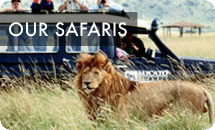Katavi




 My Safari
My SafariCall a specialist to talk about Katavi now.
Katavi National Park is a rarely visited wilderness park, remote and difficult to reach and receiving only limited rainfall. Situated relatively near to the Mahale Mountains National Park (of chimpanzee viewing fame), it was originally set aside as a reserve for animals displaced from other areas by the rains.
Despite its dryness Katavi National Park is said to have the highest biodensity of any national park in Africa, and in particular combines a large hippo population with a high number of crocodiles. In the dry season as many as 200 crocodiles can be seen sharing one cave. Many antelope are prolific here, as well as lion, elephant and one of the largest herds of buffalo containing up to 1500 animals. Over 400 species of birds including pelicans are attracted to varied woodland, acacia bush, lakes and swamps here in Katavi National Park.
Thus Katavi is very remote, unspoilt, very wild - quoted as being a veritable throwback to nineteenth century Africa. But it's difficult to get to and also expensive. Not for the first time safari goer, perhaps, but a definite possibility for anybody looking for something beyond the normal run of experiences.
Wildlife Highlights:
-
Hippo
-
Elephant
-
Buffalo
-
Lion
-
Hyena
-
Giraffe
-
Zebra
-
Impala, Reedbuck, Sable & Roan
Katavi’s most singular wildlife spectacle is provided by its hippos. Towards the end of the dry season, up to 200 individuals might flop together in any riverine pool of sufficient depth.
The best time to visit Katavi National Park is in the dry season (May to October). Roads within the park are often flooded during the rainy season but may be passable from mid-December to February.
Getting to Katavi:
By a fairly long charter flight from Dar or Arusha, or by means of a tough but spectacular day's drive from Mbeya (550 km/340 miles), or in the dry season only, from Kigoma (390 km/240 miles).
Katavi offers walking, driving and camping safaris. Near Lake Katavi, you can visit the tamarind tree inhabited by the spirit of the legendary hunter Katabi (for whom the park is named). Offerings are still left here by locals seeking the spirit’s blessing.
It is during the dry season, when the floodwaters retreat, that Katavi truly comes into its own. The Katuma, reduced to a shallow, muddy trickle, forms the only source of drinking water for miles around, and the flanking floodplains support game concentrations that defy belief. An estimated 4,000 elephants might converge on the area, together with several herds of 1,000-plus buffalo, while an abundance of giraffe, zebra, impala and reedbuck provide easy pickings for the numerous lion prides and spotted hyena clans whose territories converge on the floodplains.





